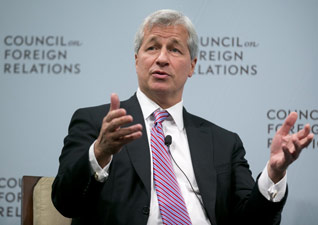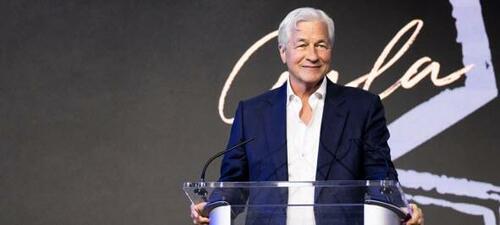This article was originally published by Tyler Durden at ZeroHedge.
Perhaps the world’s most influential banker – JPMorgan Chase CEO Jamie Dimon – warned the world in his annual letter to shareholders that while he expects US economic resilience (and higher inflation and interest rates), and is optimistic about transformational opportunities from AI, he worries geopolitical events including the war in Ukraine and the Israel-Hamas war, as well as U.S. political polarization, might be creating an environment that “may very well be creating risks that could eclipse anything since World War II.”
He begins with an ominous overview of the geopolitical chaos the world faces.
America’s Global Leadership is being challenged…
Across the globe, 2023 was yet another year of significant challenges, from the terrible ongoing war and violence in the Middle East and Ukraine to mounting terrorist activity and growing geopolitical tensions, importantly with China. Almost all nations felt the effects last year of global economic uncertainty, including higher energy and food prices, inflation rates and volatile markets. While all these events and associated instability have serious ramifications on our company, colleagues, clients and countries where we do business, their consequences on the world at large — with the extreme suffering of the Ukrainian people, escalating tragedy in the Middle East and the potential restructuring of the global order — are far more important.
As these events unfold, America’s global leadership role is being challenged outside by other nations and inside by our polarized electorate. We need to find ways to put aside our differences and work in partnership with other Western nations in the name of democracy. During this time of great crises, uniting to protect our essential freedoms, including free enterprise, is paramount. We should remember that America, “conceived in liberty and dedicated to the proposition that all men are created equal,” still remains a shining beacon of hope to citizens around the world. JPMorgan Chase, a company that historically has worked across borders and boundaries, will do its part to ensure that the global economy is safe and secure.
In spite of the unsettling landscape, including last year’s regional bank turmoil, the U.S. economy continues to be resilient, with consumers still spending, and the markets currently expect a soft landing. It is important to note that the economy is being fueled by large amounts of government deficit spending and past stimulus. There is also a growing need for increased spending as we continue transitioning to a greener economy, restructuring global supply chains, boosting military expenditure and battling rising healthcare costs. This may lead to stickier inflation and higher rates than markets expect. Furthermore, there are downside risks to watch.
Quantitative tightening is draining more than $900 billion in liquidity from the system annually — and we have never truly experienced the full effect of quantitative tightening on this scale. Plus the ongoing wars in Ukraine and the Middle East continue to have the potential to disrupt energy and food markets, migration, and military and economic relationships, in addition to their dreadful human cost.
These significant and somewhat unprecedented forces cause us to remain cautious.
Inflation and market over-optimism
And he warns that investors seem too complacent about these geopolitical risks when it comes to markets.
Geopolitical and economic forces have an unpredictable timetable – they may unfold over months, or years, and are nearly impossible to put into a one-year forecast. They also have an unpredictable interplay: For example, the geopolitical situation may end up having virtually no effect on the world’s economy or it could potentially be its determinative factor.
We have ongoing concerns about persistent inflationary pressures and consider a wide range of outcomes to manage interest rate exposure and other business risks.
Many key economic indicators today continue to be good and possibly improving, including inflation. But when looking ahead to tomorrow, conditions that will affect the future should be considered. For example, there seems to be a large number of persistent inflationary pressures, which may likely continue.
All of the following factors appear to be inflationary:
- ongoing fiscal spending, remilitarization of the world,
- restructuring of global trade,
- capital needs of the new green economy,
- and possibly higher energy costs in the future (even though there currently is an oversupply of gas and plentiful spare capacity in oil) due to a lack of needed investment in the energy infrastructure.
In the past, fiscal deficits did not seem to be closely related to inflation. In the 1970s and early 1980s, there was a general understanding that inflation was driven by “guns and butter”; i.e., fiscal deficits and the increase to the money supply, both partially driven by the Vietnam War, led to increased inflation, which went over 10%.
The deficits today are even larger and occurring in boom times — not as the result of a recession — and they have been supported by quantitative easing, which was never done before the great financial crisis.
Quantitative easing is a form of increasing the money supply (though it has many offsets). I remain more concerned about quantitative easing than most, and its reversal, which has never been done before at this scale.
Equity values, by most measures, are at the high end of the valuation range, and credit spreads are extremely tight. These markets seem to be pricing in at a 70% to 80% chance of a soft landing — modest growth along with declining inflation and interest rates.
“I believe the odds are a lot lower than that,” Dimon warns.
In the meantime, there seems to be an enormous focus, too much so, on monthly inflation data and modest changes to interest rates. But the die may be cast — interest rates looking out a year or two may be predetermined by all of the factors I mentioned above. Small changes in interest rates today may have less impact on inflation in the future than many people believe.
Therefore, we are prepared for a very broad range of interest rates, from 2% to 8% or even more, with equally wide-ranging economic outcomes — from strong economic growth with moderate inflation (in this case, higher interest rates would result from higher demand for capital) to a recession with inflation; i.e., stagflation.
Economically, the worst-case scenario would be stagflation, which would not only come with higher interest rates but also with higher credit losses, lower business volumes and more difficult markets.
Under these many different scenarios, our company would continue to perform at least okay.
AI is Transformational, but…
While we do not know the full effect or the precise rate at which AI will change our business – or how it will affect society at large – we are completely convinced the consequences will be extraordinary and possibly as transformational as some of the major technological inventions of the past several hundred years:
Think the printing press, the steam engine, electricity, computing and the Internet, among others.
…
Over time, we anticipate that our use of AI has the potential to augment virtually every job, as well as impact our workforce composition.
It may reduce certain job categories or roles, but it may create others as well.
The banking crisis is over, for now…
The mini-banking crisis of 2023 is over but beware of higher rates and recession — not just for banks but for the whole economy.
Dimon previously explained that the crisis was over provided that interest rates didn’t go up dramatically and we didn’t experience a serious recession.
If long-end rates go up over 6% and this increase is accompanied by a recession, there will be plenty of stress — not just in the banking system but with leveraged companies and others.
Remember, a simple 2 percentage point increase in rates essentially reduced the value of most financial assets by 20%, and certain real estate assets, specifically office real estate, may be worth even less due to the effects of recession and higher vacancies.
Also remember that credit spreads tend to widen, sometimes dramatically, in a recession.
Finally, we should also consider that rates have been extremely low for a long time — it’s hard to know how many investors and companies are truly prepared for a higher rate environment.
Dimon concludes:
“When terrible events happen, we tend to overestimate the effect they will have on the global economy. Recent events, however, may very well be creating risks that could eclipse anything since World War II – we should not take them lightly.”
Ambitious readers can peruse the entire 30,000-word diatribe below:











0 Comments